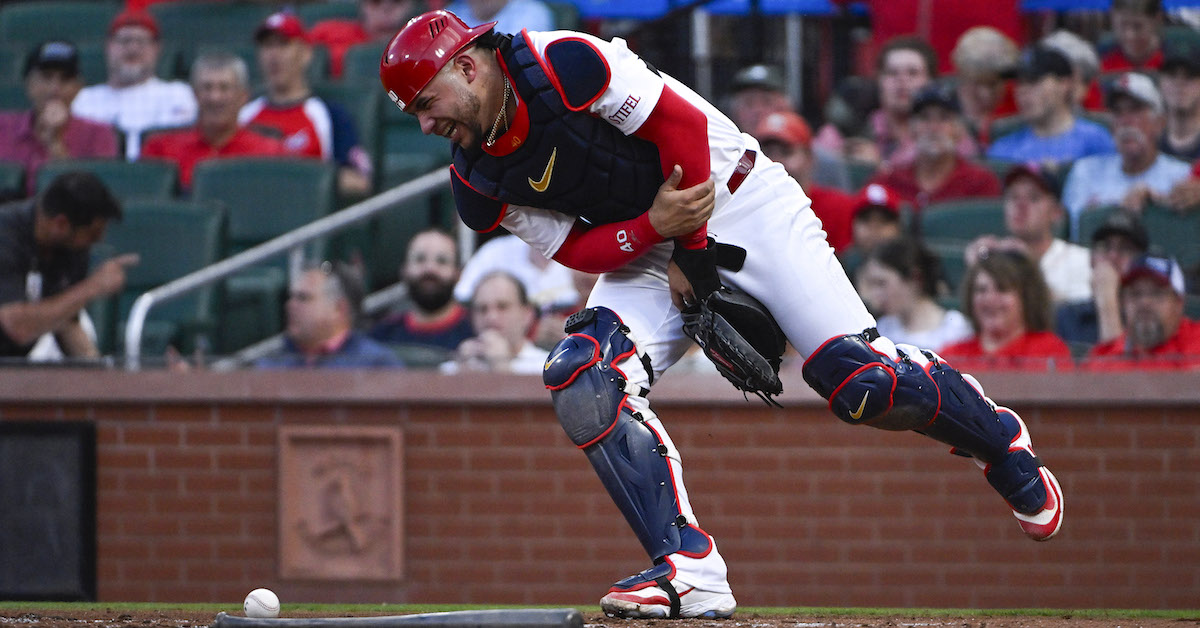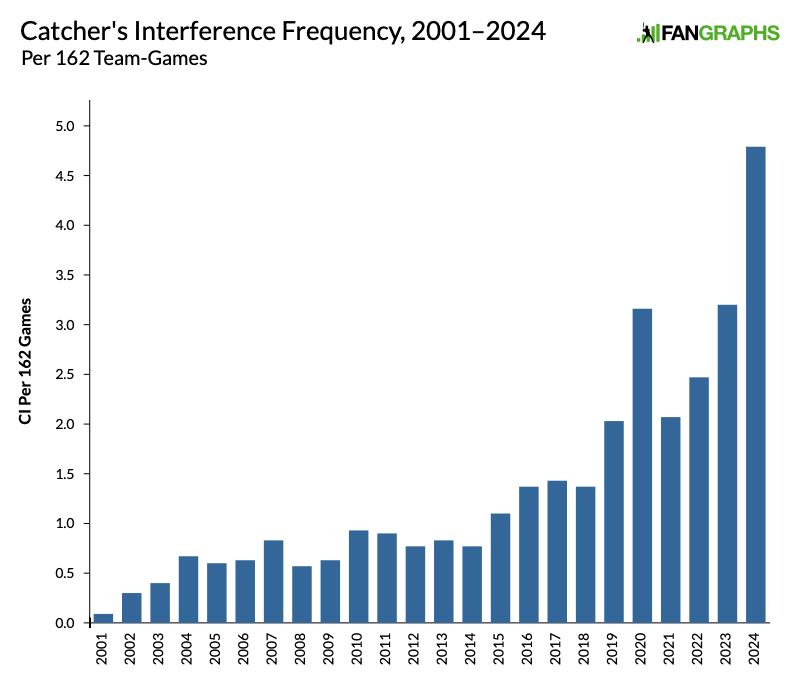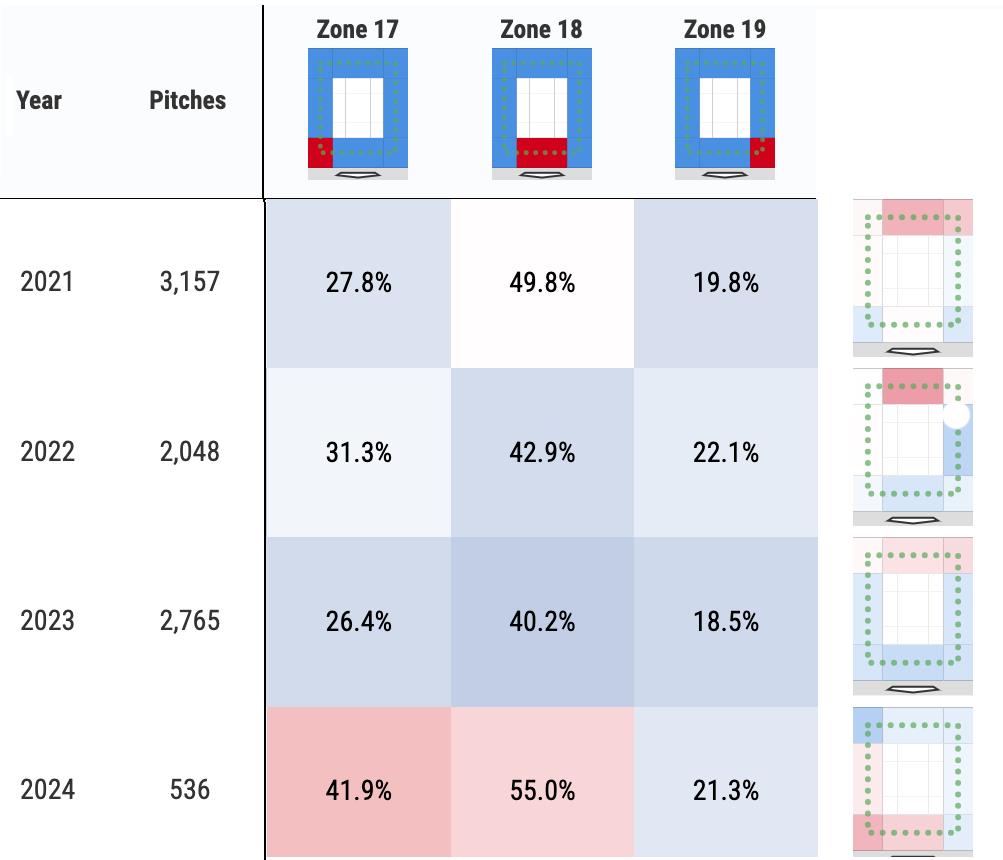
Jeff Curry-USA TODAY Sports
Willson Contreras’ tenure with the Cardinals has not lacked for drama, controversy, or interruptions in his work behind the plate. Unfortunately, the latest chapter in that saga began on Tuesday, when a J.D. Martinez swing fractured the 31-year-old catcher’s left forearm. After undergoing surgery on Wednesday, he’s likely to be out until around the All-Star break, leaving the struggling Cardinals to right their season without their most productive hitter.
The injury took place during the top of the second inning of Tuesday’s Mets-Cardinals game. With one out and nobody on base, Martinez swung at a 2-1 slider from Miles Mikolas and connected squarely with Contreras’ forearm “like a lumberjack taking a hack at a sequoia tree,” as Cardinals broadcaster Brad Thompson said. Conteras went down immediately and then began flailing around in obvious pain before being tended to by the Cardinals’ staff. Adding insult to injury, Martinez was awarded first base due to catcher’s interference. Here’s the video, which is not for the faint of heart:
X-rays taken at the ballpark confirmed the fracture, and while the Cardinals have not revealed whether it was Contreras’ radius or ulna that broke, Under the Knife’s Will Carroll reported that he did have a plate inserted because the bone was slightly out of alignment. It is worth noting that in the immediate aftermath of the injury, Contreras said he was told he’d be out six to eight weeks, but that estimate has since been revised upward to 10 weeks, which would put his return right after the All-Star break.
The injury may well have deprived Contreras of a fourth All-Star selection, as it comes at a time when he ranks among the NL’s top hitters. In his second year with the Cardinals, he’s batting .280/.398/.551 with six homers in 128 plate appearances, ranking eighth in the NL in on-base percentage, sixth in wRC+ (171), and fifth in both slugging percentage and WAR (1.8) — with his younger brother, Brewers catcher William Contreras, in close proximity (.340/.414/.517, 165 wRC+, 1.9 WAR) in most of those categories. But for all of Contreras the Elder’s contributions at and behind the plate, the Cardinals are in rough shape. They entered Friday having lost 13 out of 19 to fall to 15-22, last in the NL Central. Their odds of winning the division have plummeted from 33.2% to 5.6% since Opening Day, with their odds of making the playoffs falling from 48.2% to 14% in that same span. With Paul Goldschmidt, Nolan Gorman, and several other players in an ongoing funk, Nolan Arenado is their only remaining regular with a wRC+ of at least 100, and the team ranks last in the league in scoring at 3.43 runs per game.
While it’s easy to cast Martinez as the villain for this injury given his reputation for standing deep in the batter’s box, the reality is that Conteras was reaching into dangerous territory — part of the ongoing, industry-wide trend of catchers moving closer to the plate as a means of improving their ability to frame low pitches. As a result, catcher’s interference calls have become much more frequent; in 2023, such incidents happened 3.8 times as often as in 2013, and eight times as often as in 2003 — and right now, they’re up 50% compared to last year! Here’s a graph that shows the explosion:

As MLB.com’s Tom Tango illustrated on his blog last August, interference call rates increase the closer a catcher is to the plate (as measured by Statcast’s average location of his right shoulder) and decrease the further back he positions himself, with 66 inches behind the plate the point of inflection. The correlation between positioning and framing is such that within the 57-to-72 inch range where catchers position themselves, every inch closer to the plate is worth an extra run of framing. Meanwhile, each interference call costs about 0.3 runs. Theoretically, if a catcher moves up by six inches and adds six runs worth of framing, he’d have to get called for interference 20 times to cancel that out, but in the Statcast era, only once has a catcher committed more than five CIs in one season: the Tigers’ Jake Rogers, with six last year. Contreras had three such instances last year, matching his career high; Tuesday’s call was his first of the season.
Coincidentally, Contreras’ injury occurred one day short of the one-year anniversary of the Cardinals’ panicky announcement that the team was dissatisfied enough with his work behind the plate to move him into the DH slot while making light-hitting backup Andrew Knizner the primary catcher. The team had signed Contreras to a five-year, $87.5 million deal the previous December, but off to a 10-24 start that had everything to do with its mediocre pitching staff, president of baseball operations John Mozeliak and manager Oliver Marmol used the newcomer as a scapegoat. Marmol cited shortcomings in Contreras’ communication with the pitching staff while also conceding that Contreras had worked to improve in his bottom-of-the-zone pitch framing. Following a nine-game hiatus, Contreras was back to catching, but after starting 23 of the team’s first 32 games (72%), he started just 66 of its final 121 games (55%). The Cardinals never recovered from that dreadful start, finishing 71-91. For what it’s worth, the team went 35-56 with Contreras starting at catcher and 36-37 with Knizner or Iván Herrera.
By the pitch framing metrics of both FanGraphs and Statcast, Contreras’ framing work declined substantially from his last two seasons as a Cub to his first one as a Cardinal despite the adjustment in his positioning. By Statcast’s other catching metrics, his overall defense declined as well, though only by a few runs:
Willson Contreras’ Defensive Metrics
| Season |
Inn |
FG FRM |
FG FRM/800 |
|
SC Framing Runs |
SC SB Runs |
SC Blocking Runs |
SC Total Runs |
| 2016 |
389.2 |
2.5 |
5.1 |
1 |
3 |
— |
4 |
| 2017 |
821.1 |
-9.1 |
-8.9 |
-3 |
2 |
— |
-1 |
| 2018 |
1109.2 |
-18.2 |
-13.1 |
-10 |
1 |
4 |
-6 |
| 2019 |
811.2 |
-8.9 |
-8.8 |
-4 |
-1 |
1 |
-4 |
| 2020 |
324.1 |
1.7 |
4.2 |
2 |
1 |
1 |
4 |
| 2021 |
935.2 |
-4.5 |
-3.8 |
-1 |
0 |
2 |
1 |
| 2022 |
625.1 |
-3.5 |
-4.5 |
0 |
2 |
-1 |
1 |
| 2023 |
764.0 |
-10.3 |
-10.8 |
-5 |
3 |
0 |
-3 |
| 2024 |
164.1 |
-0.1 |
-0.5 |
0 |
1 |
1 |
2 |
SOURCE: Baseball Savant
Talkin’ Baseball had a good visual illustration of how much closer to the batter Contreras had moved:
For what it’s worth, Contreras’ rate of getting called strikes at the bottom of the zone had improved this year. Here’s a Frankensteined screenshot from his Statcast page, with the data showing his past four seasons and the called strike rates for the bottom left, center and right of the shadow zone, which you can see in context of his overall work in the far right column:

Relative to the league, Contreras has been strongest in zones 17 (seventh out of 59) and 14 just above it (fourth).
In the immediate aftermath of the injury, Marmol and Contreras both acknowledged the risks created by having the catcher move closer to the plate. “The risk is high. We just experienced it,” said the manager. “The more catchers are evaluated on framing, the closer they’re getting to the hitter to get that low pitch.”
“I think the best way to frame is to get closer,” said Contreras, who called the injury “the most painful I’ve been through, for sure.” Even so, he declined to second-guess his positioning, saying, “It could’ve been off my knee, it could be a concussion. That risk is always going to be there. I’m not blaming any part of my game because this happened tonight.”
Contreras refused to blame Martinez, either. “He saw the pitch really late and tried to get his emergency swing off, and that’s when he hit me… I think if he sees the pitch well, he would try to hit it out in front, and he wouldn’t hit me. I’m not blaming him. He’s doing his thing.”
Martinez was remorseful, saying, “You’re expecting to hit a ball and you hit an arm… I felt I hit meat. I didn’t hit just a glove, where you kind of just point back at the catcher… I felt terrible.”
While the eventual arrival of robot umps via the automatic ball and strike system (ABS) could do away with the need for catchers to frame pitches and thus allow them to move further out of harm’s way, that would only work if the full version is adopted, with every pitch being called electronically. Based on its usage in Triple-A, players, coaches, and fans prefer the challenge system version, where the home plate umpire calls balls and strikes and teams are given a limited number of opportunities to verify whether or not a given pitch was called correctly. Under that model, framing would still have its place, and teams might still chase the advantages that come with closer positioning.
As to where the Cardinals go from here, Herrera, who started 10 games last year and 16 this year, will get the bulk of the starts, with Pedro Pagés, who was just recalled from Triple-A Memphis, backing him up. The 23-year-old Herrera was once considered the organization’s catcher of the future, but while his bat has developed (Eric Longenhagen and Tess Taruskin described him as “an above-average contact hitter with plus feel for the strike zone”), he’s no Yadier Molina behind the plate. As a prospect he graded at 35 present value and 40 future for his fielding overall and 40 for his throwing. He spent most of last season at Memphis, hitting a robust .297/.451/.500 (147 wRC+) with 10 homers and an eye-opening 20.5% walk rate in 375 plate appearances; in 44 PA with the Cardinals, he hit .297/.409/351. This year, he’s batting just .232/.276/.377 (86 wRC+) through 76 PA, and his defense has been shaky. In addition to being 0-for-17 in throwing out stolen base attempts, he’s about one run below average in 145.2 innings according to both our framing metric and that of Statcast.
Before Wednesday’s game against the Mets was rained out, Marmol discussed areas where Herrera needs to improve. “The (glove-to-hand) exchange and consistency of where he’s missing (his throws) is what you’re trying to improve,” he told reporters, adding, “His footwork, exchange and being able to consistently throw and give himself the best shot on the right side of the bag is what he’s working on. A lot of his misses are on that side. And that’s something that’s technical — you can improve that.” Marmol did praise Herrera’s preparation. “He receives well, he’s continuing to work on his blocking and throwing, but the biggest improvement has been in how he’s preparing for the game. And that’s allowed him to slow the game down while he’s calling it and kind of navigating a lineup and working with the pitcher.”
The 25-year-old Pagés, a 2019 sixth-round pick out of Florida Atlantic University, is “a very sure-handed and stable backup catching prospect with a plus arm,” according to Longenhagen, adding that he has “a low-impact approach” at the plate that’s on par with a big league-ready backup. He spent last year at Double-A Springfield, hitting .267/.362/.443 (113 wRC+), and in 24 PA at Memphis this season had hit .222/.417/.500 between two call-ups that allowed the Cardinals to carry three catchers; including Thursday’s start, he’s 0-for-5 with a walk and a sacrifice fly in the bigs.
Barring a sudden acquisition of an impact player from outside the organization — and last I checked, nobody was giving away star catchers — there’s no getting around the fact that the Cardinals are going to miss Contreras a great deal. They’re reeling as it is, and won’t have an easy time turning themselves around without one of their key players.
Source
https://blogs.fangraphs.com/willson-contreras-and-the-cardinals-catch-a-bad-break/
 Backyard GrillingWeekend WarriorsAdvice from DadBeard GroomingTV Shows for Guys4x4 Off-Road CarsMens FashionSports NewsAncient Archeology World NewsPrivacy PolicyTerms And Conditions
Backyard GrillingWeekend WarriorsAdvice from DadBeard GroomingTV Shows for Guys4x4 Off-Road CarsMens FashionSports NewsAncient Archeology World NewsPrivacy PolicyTerms And Conditions
